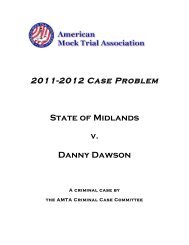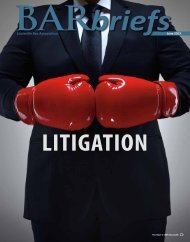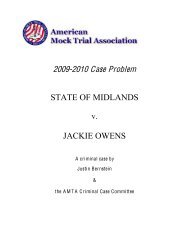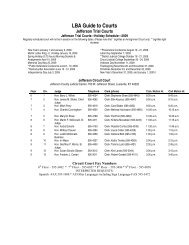Corporate Affiliate Conflicts of Interest - Louisville Bar Association
Corporate Affiliate Conflicts of Interest - Louisville Bar Association
Corporate Affiliate Conflicts of Interest - Louisville Bar Association
Create successful ePaper yourself
Turn your PDF publications into a flip-book with our unique Google optimized e-Paper software.
Book Review<br />
Secrets <strong>of</strong> the Kentucky Supreme Court<br />
D. Scott Furkin<br />
After 31 years in the judiciary, the last 24 as a member<br />
<strong>of</strong> the state’s highest court, retired Justice Donald<br />
C. Wintersheimer knows as much as anyone about<br />
Kentucky law and the personalities who shaped it over the<br />
last three decades. He shares much—but not too much—<strong>of</strong><br />
what he learned in a new memoir, Secrets <strong>of</strong> the Kentucky<br />
Supreme Court (Adams Avenue Books), self-published<br />
earlier this year.<br />
In keeping with the character <strong>of</strong> Justice Wintersheimer—<br />
highly regarded for his integrity, gentility and discretion—<br />
there are no insider accounts <strong>of</strong> dialectical dustups between<br />
his colleagues or ribald revelations about their personal<br />
peccadillos. He surely could have written <strong>of</strong> these, but<br />
then the book would have to be entitled Dirty Secrets <strong>of</strong><br />
the Kentucky Supreme Court.<br />
Perhaps the closest Justice Wintersheimer comes to expose´<br />
is his retelling <strong>of</strong> an incident that occurred in 1994<br />
when the Supreme Court traveled to northern Kentucky<br />
for oral arguments at the Chase College <strong>of</strong> Law. After one<br />
argument, a Catholic nun who had been in the audience<br />
approached him and mentioned that she thought several<br />
<strong>of</strong> the justices behaved rudely by frequently talking<br />
amongst themselves while the lawyers were addressing<br />
the court. “This little episode highlights one <strong>of</strong> my pet<br />
peeves with some <strong>of</strong> my colleagues, most <strong>of</strong> whom were<br />
on the left side <strong>of</strong> the bench as you faced it,” he writes.<br />
“Talking among members <strong>of</strong> the court during argument<br />
is just that—rude.” True to form, Justice Wintersheimer doesn’t name names, but<br />
court-watchers familiar with the court’s makeup at that time can deduce the <strong>of</strong>fenders’ identities.<br />
The largest portion <strong>of</strong> the book is devoted to Justice Wintersheimer’s reflections on the many<br />
published opinions he authored during his long career on the high bench. Summarized are<br />
nearly 700 cases decided by the Supreme Court between 1983–2006 in which he either wrote<br />
a majority, concurring or dissenting opinion. Because a number <strong>of</strong> the most significant decisions<br />
rendered by the court during that time are referenced, it is compelling, albeit somewhat<br />
tedious, reading for anyone interested in the development <strong>of</strong> modern Kentucky case law.<br />
The book gives a glimpse <strong>of</strong> behind-the-scenes judicial operations—things like how case assignments<br />
are made, how preliminary decisions are reached in conference room discussions<br />
immediately following oral arguments and how final votes are tallied after draft opinions have<br />
been circulated amongst the justices.<br />
“The daily activities <strong>of</strong> the Court are not well known because in some ways the Court does<br />
operate out <strong>of</strong> the public spotlight,” notes Justice Wintersheimer. “Certainly most <strong>of</strong> our work<br />
occurs in the reading, research and writing in our own chambers or <strong>of</strong>fices.”<br />
There are also some interesting insights into the court’s processes. For example, Justice<br />
Wintersheimer points out that only about 15 percent <strong>of</strong> all discretionary review motions<br />
filed in the Supreme Court are granted with the remaining 85 percent being denied. He goes<br />
on to observe that “once a case is granted review, the percentages are almost reversed in<br />
that 85 percent <strong>of</strong> the grants ultimately result in reversal, and only 15 percent <strong>of</strong> the original<br />
decisions are affirmed.”<br />
The most enjoyable parts <strong>of</strong> the book are those that reveal something <strong>of</strong> the personalities <strong>of</strong> the<br />
jurists with whom Justice Wintersheimer served over the years. There are several references<br />
to the late Justice Charles M. Leibson, with whom he enjoyed a cordial relationship despite the<br />
fact that they frequently clashed over legal and constitutional issues. Justice Wintersheimer<br />
writes that he once suffered mysterious pains which led to his being hospitalized in Frankfort<br />
for several days while the court was in session. “Other than my wife and daughter, the only<br />
visitor I had was Justice Leibson,” he recalls.<br />
Anyone enticed by the title to expect a “tell all” tome will be disappointed<br />
by this book. However, those interested in what the state’s highest court<br />
was up to as a new millennium dawned will find it a worthwhile read.<br />
As Justice Wintersheimer aptly notes in the conclusion: “(A)lthough there<br />
is some mystery surrounding the Kentucky Supreme Court, the real secret<br />
is that there is just a lot <strong>of</strong> hard work.”<br />
D. Scott Furkin is the Executive Director <strong>of</strong> the <strong>Louisville</strong> <strong>Bar</strong> <strong>Association</strong>. •<br />
www. loubar.org October 2010<br />
5







